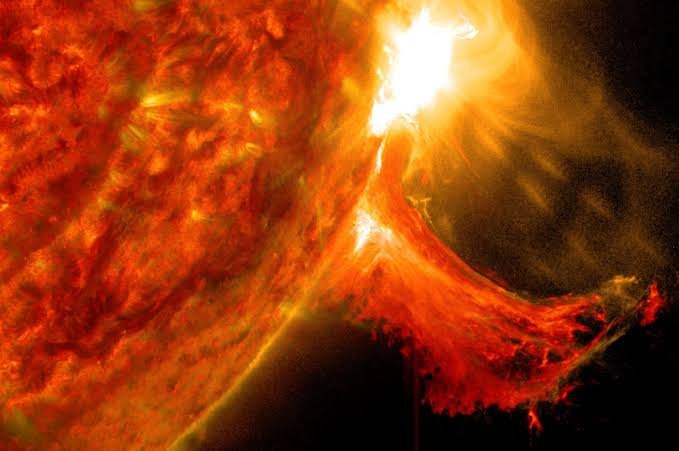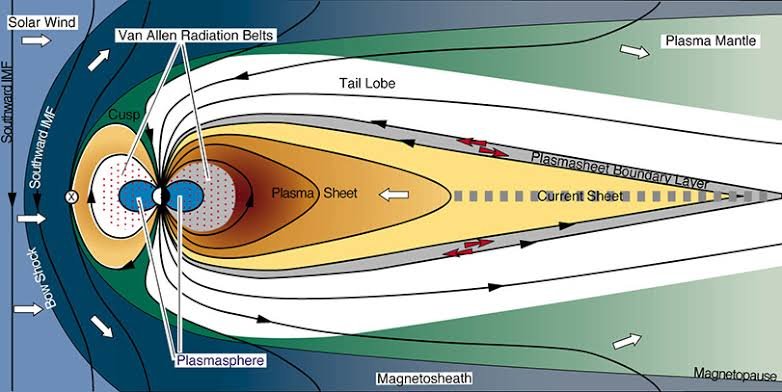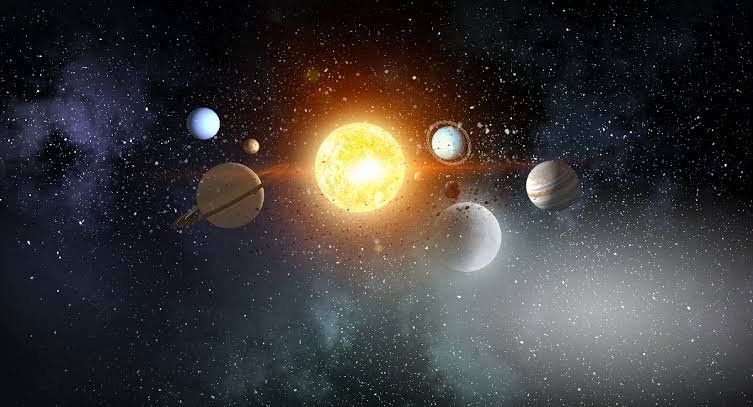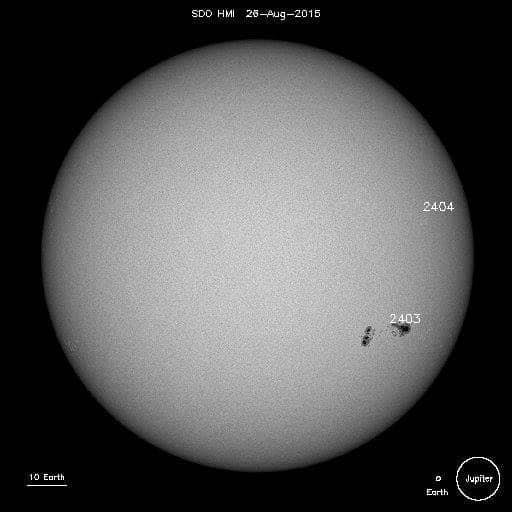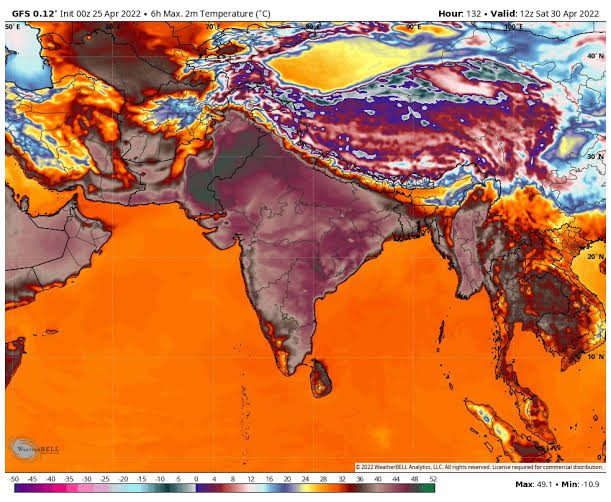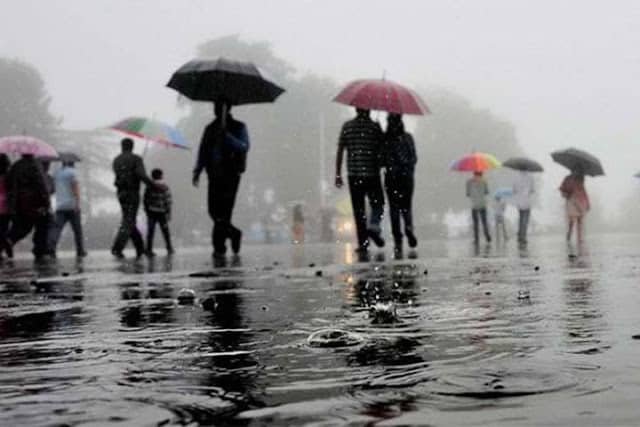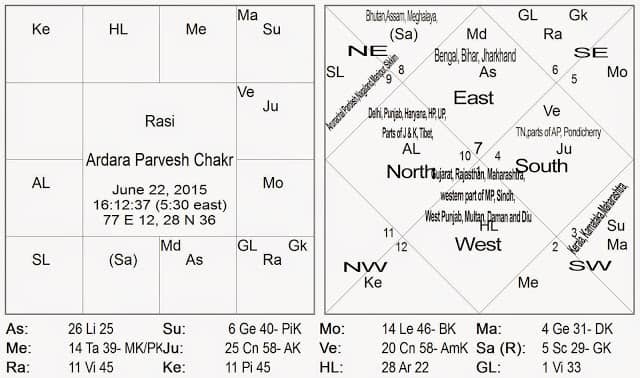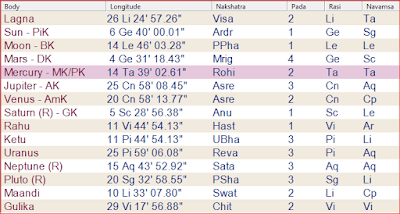As per vedic medini calculations; South-West monsoon could strike over kerala, AP and Andaman Nicobar probably around 8th of June 2015 approximately @ 17:17:44 hr. with good possibility of heavy blow of wind around coastal regions and rainstorms could be possible at later stage. Entry of monsoon should bring heavy rainfall might be less in contents of water but with good amount of contents of winds in it around south west coastal regions of India. Coastal regions need to take care of heavy wind and rainstorms from 8th of June onward.
As per mirgshara parvesh Chakara, Sun will enter in Mrigshara Nakashtra on 8th of June 2015 approximately around @17:17:44 Hr. and this could be the time, exactly when Monsoon can hit over coastal regions of Goa, Kerala and Andhra Pradesh with heavy wind and rainfall and later it can move over Mumbai and other SW states of India.
If we look at “ Mrigashara Parvesh chart “ – Libra Lagana (Vayu rasi – having 25% water content – 75 % Air) is rising and 8th house from lagana is having Mars, Sun and retrograde mercury in Taurus sign – “ The sign of bhumi (Earthy Sign) “ – having 50% water and 50% heat contents, rules heat beneath the earth and mostly weather Sensitive nadi’s are fall in it, majorly responsible for weather changes in Beginning of Monsoon around SW State of India – i.e. “ Prachand Nadi” (Kritika Nakashtra falls in it Signifies- Extreme heat and dryness in environment ), “ Pawan Nadi “ (Rohini Nakashtra falls in it signifies – Amount of Vayu and indicates quantity of wind flow in places falls in this nakashtra i.e. Wind Storms and Rainstorms has been observed whenever Sun ingresses in it) and “ Dahan Nadi “ (Indicates highly sensitive to heat and air work according to changes in environments – usually gives hot atmosphere, humidity, sparking lights or thunderstorm during Monsoon season ). One of most important factor is Sun, Mars and Mercury getting aspect by Saturn from 2nd house (also in Prachand Nadi), there will be presence of delay and void in rainfall volume at later stage. Further it indicates presence of Lightening and thundering soon after Entry of SW monsoon in AP and coastal areas of Kerala.
Whenever Mars conjoined with Sun and Mercury – Heavy Windstorms with Thunderstorms are likely to seen or observes in weather trends whenever strike in those areas orbiting at that time, due to magnetic disturbances in solar regions and also considered as an one of strong factor for affecting ionosphere and earth atmosphere.
In Mrigshara chart both Rahu (North Node) and Saturn are in 2nd house (Anuradha Nakashtra, Scorpio Sign – having water and heat content ratio of 25 % & 75 %) and 12th house forming Paap-Kriti Yoga to lagana – Clearly indicating – Monsoon should hit SW area strongly and sudden changes in weather could also been observe in later stage, might be there could be sudden decay or fall in pattern of rainfall after thunderous beginning and there will be strong possibility of monsoon may move over other adjoining areas of Kerala with heavy rainfall and winds. As strong possibilities of water and moisture contents are indicated from Mrigshara Parvesh chakar, it seems adjoining areas of Kerala and other coastal regions of India may face threat of cyclones or whirlpools around this period.
“In Short we can experience low pressured heat waves with stronger possibilities of Rainstorms and thunderstorms after 8th of June 2015 in SW regions; the only concern could either ratio of rain would be too high or too low, Volume of Rainfall will be variable in state as compared with last year Monsoon patterns but during this current monsoon we may see richer quantity of air composition in rainfall and we may see threat of storms around these periods but it won’t be for much longer period as there is no relation of nodes with Sun, Mars or mercury in Mrigshara Parvesh Chakara.
Moving further for rest of India Weather trend “look at the “Ardra Parvesh” chart for 2015 casted for @ 22 June 2015, Time – 16:12:37 HR and place – New Delhi or you can take Varanasi or Vidisha (Centre of India) as suggested by Varahmihra for entry of Sun as observed in Ujjain in Ardara Nakashtra ”
Lord of the Clouds for year 2015(Maighesha)
Ardara Parvesh Chakara 2015
As per classical texts lord of the day on which the sun enters Ardara Nakashtra constellation is considered as “The Lord of the clouds” for that year. In 2015 Sun enters in ardara Nakashtra on 22nd of June exactly around 16:12:37 @HR in “ Shukala Shashti tithi “ (Venus) on Monday (Soma) and the lord of the Day “Moon” will be in Poorva Phalguni Nakashtra (Jala Nadi). So, Lord of the cloud will be the ruling planet of the day and for 2015 it is Moon (Maighesha) clearly indicating a good indication for on time Monsoon on SE States and rest of Indian states.
Maighesh is placed in 11th house in (SE Zone of India) in Agni Rashi but in Poorva phalguni Nakashtra (ruled by Jala Nadi) with (North Node) Rahu in 12th house (ruled by Saumya Nadi) in ” Hastha Nakashtra ” getting aspects from mars from 9th house – This shows that this year Immense Heat waves will rule most of the regions in India but at the same-time we can experience good number of rainy moments too – In Short there will be Sudden and frequent shifts in weather trends.
On 20th of May 2015 when Sun was Moving around “ Rohini Nakashtra “ (Indicates amount of Vayu in atmospheres and quantity of wind flow in places falls in this nakashtra and if it is under Hot and dry planets this nakashtra usually gives Immense Heat waves and Dry Environment) and we will see increase in dryness in atmosphere with certain amount of warm weather conditions will be there too, heat waves and wind Storms will create panic in SE Zones of India with frequent changes in weather trends. Later there could be sudden and dramatic weather changes experience in (South-East) Zone of India which Includes below mentioned States:-
“Orissa, Parts of West Bengal, Parts of Andhra, East – Coast, Andaman and Nicobar”
Presence of maighesh in Jala Nadi in SE clearly indicating good amount of rain in North- East region but with sudden shifts in weathers patterns, as North Node is also ruling other portion of SE.
Later When Sun will ingress and mature in Mrigshara Nakashtra degrees around (23′ 20) in Taurus, there could be better rainfall expected in (SE Zone) when Sun will move around “8th of June 2015″.
Tithi Lord Venus is also happen to be Lagnesh (Libra Lagan (Airy) – 25 % Water composition) placed in 10th house (South Zone of India) with Jupiter in (Ashlesha -Nakashtra of Cold and fine weather patterns, mainly seen for good number of rains) in Jala Rashi (having water composition of 100 % Rains) in “ Amrita Nadi ” Aspecting North of India (Capricorn – having 100 % water content). Indicating there will be chances of plenty of Rainfall and good winter season this year in north of India but monsoon will be bit delayed (we can expect initial entry of monsoon in north India after 16th-17th of July).
As 4th house (North) is getting aspect of “Mars, Saturn and North Node “- there will be presence of both warm and dry atmosphere as well as higher chances of sudden and dramatic weather changes within in shorter period, rise in temperature could be seen around 42 to 45 to 47 degree but later when monsoon will mature from 21st of July to first week of august 2015 we may see case of lightning and thunderstorms with heavy rainfall but for short period and most important point to notice could be volume and quantity of rainfall could vary in ratio, as sometime there could be good amount of Rain but later it may fall in North of India including following states:
” New Delhi, Punjab, Haryana, Himachal Pardesh, Western U.P and Jammu and Kashmir ”
Clustering of Jupiter and Venus in Jala and Amrita Nadi clearly telling, there will be plenty of rainfall in southern zone of India from the beginning of monsoon but in later stage when sun degrees will matures in Ardara Nakashtra we might see some fall in ratio but still Southern states will enjoy good amount of rainfall this year.
This Year Both Sun and Mars are closely sitting in 9th house in (Airy Sign – having gemini sign with 0 % water content) Ardara Parvesh Chakara Ruling (South-West Zone of India) indicating this year South-West zones of India will face sudden and warm climatic changes including too much heat waves will be spread over in most of western regions and it might results greater amount of Moisture and heavy rainfall even both the planets are in Gemini sign as 9th house is getting Sustenance from both Jupiter and Venus being in 2nd from Both Sun and Mars, although it is 2/12 relationship, pattern of rainfall won’t be common and easily noticeable but still it would give heavy rainfall. With this heavy wind storms can also be experience in some of coastal regions of western regions of India and it can shape into heat waves which might be rich in low pressure warm winds. Before that there will be chances of intense warm weather and dryness in SW zone of India and in some of places dusty wind storms can also be experience which are closer to center of India and later when sun will move further rain will come with thunderstorms.
SW Zones includes following states –
“Some part of Mumbai near to coastal regions, Andhra Pradesh, Telangana, Kerala as well as the union territories of Lakshadweep “.
This year Mars is in (Dahan Nadi – heavy blow of wind) having 6/8 relationship with Saturn (Prachanda Nadi – fierce form ) and having 2/12 Relationship with Jupiter (Amrita Nadi – good amount of rain) – Indicating this year Mars, Sun and Saturn will create Panic in Central, SW and Western regions of India in the form of Intense heat waves, untimely floods, thunderstorms and wind storms as most of the malefic planets are in Vayu and Agni Nadi’s zone – heat waves, windy storms, Intense warm and dryness will be in peak this year, Destruction of lives could be there due to increase in Heat and Wind in atmosphere can resulting untimely rainfalls and floods. Though Mars and Rahu are in 4/10 Relationship – situation will increases slowly as sun further ingresses into next nakashtras in July and August 2015.
Role of Rashis in Aradara Parvesh Chakra for 2015
For Casting Ardara Parvesh chakara we need to analyze twelve rashis which have been divided in to following categories on the basis of water, air and heats contents they possess based on geographical nakashtras placements:
1. Fiery: Aries 25%, Leo 0% and Sagittarius 50%
2. Earthy: Taurus 50%, Virgo 0%, and Capricorn 100%
3. Airy: Gemini 0%, Libra 25%, Aquarius 50%
4. Cancer: 100%, Scorpio 25%, Pisces 100%
Planets which are beneficial in nature and are closer to earth orbit i.e. Moon, Venus, Mercury and Jupiter have deeper impact and usually gives plenty of rainfall while those are malefic planets and having bit further larger distance and having slower movement have long lasting and stronger impact with respect to earth i.e. Sun, Mars and Saturn have deep impact on monsoon and also known for major preventing factors for regular rain as most of these planets are dry and warmer in nature.
Directions and Places in the Horoscope
For Analyzing Ardara Parvesh Chakara Lagna is always considered as an East of India (where sun rises), 10th house considered as South of India, 7th houses for west of India and 4th house is considered as north of India and states which are belong to these 8 directions based on geometry of India are as follows :
1. East (1st House) : Bengal, Bihar, Jharkhand, Mizoram and eastern MP.
2. North East (2nd &3rd houses) : Bhutan, Assam, Meghalaya, Arunachal Pradesh, Nagaland, Manipur and Sikkim.
3. North (4th house): Delhi, Punjab, Haryana, HP, UP, Nepal, Parts of J & K, Tibet, and Uttaranchal
4. North West (5th & 6th houses): Baluchistan, Rawalpindi, Peshawar, Afghanistan, western region of Jammu & Kashmir.
5. West (7th house): Gujarat, Rajasthan, and Maharashtra, western part of MP, Sindh, West Punjab, Multan, Daman and Diu
6. South West (8th & 9th houses): Kerala, , Coastal regions of Maharashtra, West coast and Goa
7. South (10th house) : TN, Karnataka , parts of AP, Pondicherry
8. South East (11th &12th house) : Orissa, parts of West Bengal, parts of Andhra, East Coast, Andaman and Nicobar
Important factors
1) Role of Sun and Mars: If both Sun and Mars are closely conjugated or having close relations in same house in Ardara Parvesh chakra, usually gives intense dry and warm weather for that year and there will be intense heat waves before start of monsoon. If Sun is behind Mars, there will be possibility of no rains for whole monsoon season.
2) Sun and Saturn: Whenever both sun and Saturn are closely placed in one rashi, usually in summer, intense heat waves observes and in winter usually observes acute cold with good amount of Snowfall.
3) As per mundane rules Saturn is considered as karaka for dry and cold winds and usually it gives dryness and acute coldness in atmosphere’s depends on seasonal changes and whenever it is placed in Jala Nadi it usually gives Strong windstorm of water and air and storms can cause massive cyclones in coastal regions and wrecking of ships via thunderstorms is a role of mars when it is with Saturn or getting aspect from mars in coastal areas. If Saturn is in airy nadi, it usually drives away all the clouds responsible for rain with its huge blow of wind and dryness.
If Saturn is in Agni nadi, it usually gives intense dry heats waves; Dusty wind storms and heavy storms which are very powerful and even can break any buildings or obstacle come over their paths.
Role of Sapta Nadi Chakra in Monsoon
Sapta nadi Chakra is again a very useful tool or an ancient chakra schemes used by our sages in predicting weather, floods, thunderstorms and heat waves patterns especially for rainfall and it is a best tool to use for predicting Monsoon activities in India around sun movement in ardara Nakashtra.
Though it can be used for world Rain patterns but it needs extensive work on with Koorma Chakra for World charts for locating Nakashtras. Mostly Explanation of Sapta Nadi Chakara is widely seen in two ancient sources of Saptanadi Chakra – Narapati Jayachara and Sage Parashara and all later texts are based on them. Original source of Sapta nadi Chakra was a tantric text titled ‘yamaleeya-Svarodaya’.
As Explained by Narapati Jayachara , it is used for Calculation on quantity of rainfalls starting from Kritika Nakashtra.
4 Nakashtras Scheme are widely used in Sapata Nadi chakara system.
“ Kritika, Vishakha, Anuradha and Bhari Nakashtra “ categorized in Parachanda Nadi (Chanda Nadi) ruled by Saturn.
“ Rohini, jyestha, Swati, Ashwani “ nakashtras are fall in Vayu Nadi ruled by Sun. “Mrigshara, Chitra, Moola, Revti “ are fall in Agni Nadi and ruled by Mars. “Ardara, Hasta, Poorva ashadha , Uttrabhadra “ fall in Soumya Nadi ruled by Jupiter.
“ Punurvasu, Uttraphalguni, Uttra ashada , Poorva bhadra” are fall in Neera Nadi ruled by Venus. “ Pushya , Poorva Phalguni, Abhijeeta, Satabhishaq “ are fall in Jala nadi ruled by Mercury.
“Ashlesha, Magha, Sharvana, dhanistha” are fall in Amrita Nadi ruled by Moon.
Prachanda Nadi usually gives huge blow of wind, Vayu Nadi gives normal volume of winds and Agni Nadi gives Immense Heat and warm weather.
Neera Nadi usually gives clue of entry of clouds and in Jala and Parachanda Planets give heavy rainfall.
If there is placement of Malefic, Moon and Beneficial planet in same sign or same nakashtra it usually gives huge amount of rainfall.
If there is Moon and any planet conjugated in same nakashtra at same day it gives heavy rainfall for continues 2.5 days till moon is conjugated with that planet.
If in Amrita Nadi both Malefic and Benefic planets are placed with moon it usually gives continues rain up to 3,4 or maximum up to 7 days.
In Jala Nadi If Moon is with Both Malefic and Benefic it can also give rain up to 1.5 or 5 days.
If in any nadi there is Moon, mars and Jupiter are closely placed it can also drown whole earth for some days. During planet direct motion, retrograde motion, and combustion and during any planet movement in sankranti in Jala nadi it usually gives excessive rainfall for few days.
Placement of Mars ahead than sun has capability to suck all clouds which are meant for heavy rain, it usually gives warm weather with no rain.
Mars with Sun usually gives excessive heat waves and warm weather and much possibility of high humidity.
For making a Sapta nadi Chakara we need to use 28 Nakshatra scheme. 28th Nakshatra ‘Abhijit’ is also allotted a space towards the end of Uttarashada.
These Nakshatras are subdivided into 7 Nadis starting from ‘Krittika’ (3rd Nakshatra) as ‘Vaat Nadi or Airy Nadi ’ followed by ‘Ati-vaat or PrachandNadi’, ‘Dahan’, ‘Soumya’, ‘Neera’, ‘Jala’ and ‘Amrita’.
Usually Vaat produces windy weather, Ati-vaat produces cold weather after Rainstorms, Dahan increases temperature depending on the environment as Dahan Nadi is very sensitive nadi wrt to nature and surroundings and it gradually increases with the time and environment, and Soumya, Neera, Jala and Amrita nadis are rain producing Nadis.
If there is in any case an unnatural activity has been observes in Saptanadi chakra, we can same also confirm via “Casting Hindu Near year chart for India “ based on entry of sun on “ Chaitra Shukala partipat tithi “.
By casting Hindu New Year chart we can cross check for any unnatural activity is damaging to country or not and what could be future situation for rain and crops in that particular year.The Sapta nadi chakara sequence follows a serpentine pattern as we have assigns Nakashtras based on Serpents in below mentioned Diagram, as suggested by shiri Narpati Jaicharya ji:
 |
| (Ancient Saptanadi Chakra suggested by Narapati Jaichar, Image Source -Saptanadi Chakara , By Narapati Jaya charasarvadoyo by Dr Sataynder Mishra) | |
Now let’s prepare Sapta nadi chakra for Year 2015 on the basis of Ardara Parvesh Chakra.
 |
| (Nakashtra Details of Ardara Parvesh Chakara) |
Sapta nadi Chakara for 2015
Important Principal’s on Nadi’s
1. Soumya Nadi is known as Madhya Nadi (after Sankranti Season), ruled by Jupiter which indicates maintaining & balancing season to give Soothing monsoon.
2. Prachand, Pawan and Dahan: known as Yamya Nadis or Dakshina Nadis (after Sankranti Season) means extreme heat of the summer.
3. Neera, Jal and Amrit: known as Uttara Nadis (Rainy Season), neera ruled by watery planet venus indicates good rains in Monsoon season, Jala ruled by Mercury, means water and indicates plenty of rain in monsoon when it is with Jala grahas like Moon and Venus and Amrita ruled by Moon – a potent Watery planet and can gives rain in abundance and also torrential down pour.
4. Amrita is also known as Sheetal (Winter Season) also indicates plenty of rain or good and cold winter season.
5. When many planets are in a single rashi, especially in one nakshatra with Mars and Sun joins them and Mars is with Rahu, there can be terrible downpour, even if it is not rainy season
6. If Moon joins with Venus or in trine to it, weather fluctuation usually takes place in rainy season with possibility of good rains.
7. Transit of Mars is most important in Saptandi chakra as it gives different results in different signs and transits form one sign to another matters much in rainy season and it can give, perceptible change in weather within 2 or 3 days if it has having any link with Jala Grahas or jala Nadi. Mars is the most powerful planet causing rainfall or deteriorating it when it is placed behind or with sun by promoting warm weather and humidity.
8. If a major planet changes signs or nakashtras, noticeable change in weather can be expected soon within next 15 days.
9. Whenever any planets become retrograde or become direct, there can be change in temperature or in humidity level if it is rainy season and if it is winter there can be increase in cold or soothing wind. Mercury is an important planet to notice whenever it is conjoined with Jala Planets in Jala nadi’s i.e. Moon and Venus or when mercury is closed to earth. Venus alone, either retro or direct, cannot influence weather it need catalytic factor with moon and mercury.
10. If strong there is strong placement of Moon in sign is aspected by the dispositor lord , rains can be possible within next 2.5 days.
11. More beneficial planet in Dakshina Nadi, more possibility of rains. More malefic planets in Uttara Nadi, zero possibility of rains.
12. Important factor to notice in Cloud formations or change in clouds whenever there is close relation of Mercury and Venus, Mercury and Jupiter and Venus and Jupiter during change in nakashtra or in signs. In favorable signs and favorable aspects, rain is more possibly to come.
13. Usually Venus behind slow moving planet causes wind or soothing and nice season and many planets in Pawan nadi usually cause Storms, strong blow of win or it can destroy crops too.
14. Whenever Sun in between Venus and Mercury there will be dry spell for a few days or there can be a break in rain pattern.
15. Close relation of Jupiter and Mars within 30 degrees in same signs or same nakashtras usually prevents rain or absorbs rainy clouds.
Analysis of Monsoon 2015 based on Sapta nadi Chakara and Ardra Parvesh Chakara.
In Ardra Parvesh chakra, Libra sign, which is an airy rashi with 25% of water content, is rising. The ascendant is hammed between the malefic Rahu and Saturn (both are dry planets).Beneficial Jupiter is placed in 10th house in Jala Rashi(Cancer – South Region) aspecting Saturn ( placed in 2nd house – NE Region) and 4th house ( North Region – ruled by Capricorn Sign).
Moon is in Simha rashi with 0% possibility of water content but in Jala Nadi- there will be wide spread dry spells in SE region in beginning of season but in later stage we can observe see good amount of rain around August -September 2015.
In D9 chart Taurus rashi, with 50% of water content, is rising with Mercury is placed in it aspected by Saturn (Dry) and Mars (Heat) – clearly an Indication of Dry, Warmer and heat Wind spell this year for 2015.Now see the position of planets at the time of Ardra Parvesh in the Sapta Nadi Chakra.
At the time of Ardra Parvesh Moon is in Poorva Phalguni Nakashtra inNeera nadi which is considered as good for timely monsoon rains in most of the part of North and east regions.
As many as five planets Mars, Mercury, Saturn and Uranus are present in “Yamya” nadi’s i.e Prachand, Pawan and Dahan Nadi’s – which shows there could be intense heat waves spread all over India at the time of Ardra Parvesh, around 22 June, with possibility of rain at some places in the west/south- west zone but quantity and volume does matters.
Rest of Places in north east and central may under dry spell of heat and winds.
After doing lots of assessment based on “ Sapta Nadi Chakra “ concluded results based on 8 zones of India :
For whole (India)
When Sun prepares to enters in ” Mrigashira nakashtra” around about end of May (20th of May) and most probably in first week of June (8th of June 2015) , Southwest monsoon will enters into Indian Subcontinent from west coastal areas and usually strikes over the coastal region of Kerala and Andhara pardesh and when sun enters into Ardara Nakashtra ( on 22nd of June 2015), Monsoon will enters into Northern Regions of India. When Sun enters in Cancer in Pushya Nakashtra on (21st of July 2015) most important phase of monsoon will strike over northern zone of India including New Delhi, Punjab, Jammu and Kashmir and other North Indian states.
South west monsoon will reach Delhi and others part of north India around July 17th and it will start maturing after 21st of July 2015.There will be an average or lesser rain will be notice till July 17.After July 17-21, 2015 there will be good chances of rain all over India particularly in North and West Directions of India. We can expect flood like situation over Eastern states probably around (i.e. Bihar, west Bengal’s etc.) probably around June month. Month of August and September 2015 will be much focus for South Eastern States.
If i would like to define a single word for 2015 – This year will be hottest year with temperature can goes up to 45 to 48 degree, Central, South west and Eastern States need to take care of Extreme heat and Dry spells during June and August month.
When Sun’s enter in to Kanya (after 17th Septembers 2015), there will be beginning of Monsoon with drawl from Northern Region Mostly from Kashmir and other Northern States mainly due to western disturbance and it start enters into Bihar and other eastern regions. When Sun’s enter into Hastha nakashtra on 28th of September 2015 in Virgo Sign , there will chances of backward rains in Bihar region which we called “ hathiya rain “. When Sun enters into Chitra Nakashtra on 11th of October 2015 , there will be Some occasional rains or it may mean withdrawal of South-West monsoon from India.
This year Mars is in (Dahan Nadi) having 6/8 relationship with Saturn (Prachanda Nadi) and 2/12 Relationship with Jupiter(Amrita Nadi) – Indicating this year Mars, Sun and Saturn will create Panic in Southern and Western regions of India in the form of Intense Heat waves, thunderstorms , floods, Un even Rainfall and Wind storms as most of the Malefic planets are in Vayu and Agni Nadi’s Zone – Heat waves storms, windy storms, intense heat and dryness will be in peak this year around June and august month. Destruction of lives could be there due to increase in Heat and water in atmosphere.
For South (S) India – There will be above normal rain in South direction, as Jupiter and Venus both placed are placed in Watery Sign – Known for good Rain fall around monsoon. So, good rain can be expected around Godavari, Krishna, Tungabhadra, Kaveri, and Vaigai rivers which are important non perennial sources of water around June and July month.
Chennai, Bengaluru, Hyderabad, Visakhapatnam, Coimbatore, Kochi and Thiruvananthapuram will be good for Rainfall this year during monsoon season.
For Central and South West (SW) India – During May 2015 month Mars, Sun and Retrograde Mercury stays in Taurus – sign representing south-west and Central India direction which clearly indicates, There will be too much heat waves spreading over central India to Southern-Western region of India including Mumbai, Madhya Pradesh, Ap, Kerala and Telanagna and till sun, mercury and mars are closely moving over Nakashtras of Rohini and Kritka and aspect-ed by Retrograde Saturn from Scorpio around 15th June 2015 – Central and South-Western India will be panic by drastic heat waves spells and extreme warm and Dry weather. Temperature could go around 45 to 49 Degree around 15th June 2015.
In Ardra Parvesh chart, Both Mars and Sun will be placed in Gemini signs, indicates it can give erratic monsoon for the places in this direction i.e. Kerala, Karnataka, Maharashtra, Mumbai and West Coast could face Humid atmosphere, Dry spells of winds around may month and warm weather this year around July 2015 but in August-September month situation could be different.
Beginning of Monsoon in SW will be furious and erratic and excessive rainfall can be experience with lots of hailstorm and thunder showers with lightning around June 2015.
For East and South (E, SE) – Places in the east Bengal, Bihar, Jharkhand, and eastern Madhya Pradesh could face Sudden blow of dry wind spells before monsoon season as no planets are aspecting it and most important factor, it is hemmed between Rahu and Saturn from both sides in Ardara Parvesh chakara. It seems Bihar and Eastern Region gone face Sudden blow of Windstorms this year and it will pick heap after when Jupiter will move into Leo sign in July 2015.
From July 14 to July 1, South -East Region can experience sudden erratic weather condition and change of trend in temperature will be there – as three planets are going to Participate in Ardara Nakashtra (Saumya Nadi ) – Sudden blows of wind can give change in trend of temperature and Moon will help in creating low pressure around coastal areas – Result we can expect Rain.
Though Sun is away from this conjunction – Temperature will break out. At the same time Jupiter is shifting its Major Position in Leo Rashi (Having 0 % Water content) and also going to Join in Magha Nakashtra in Amrita Nadi – Nakashtra of Suddenness, rules Eastern States (i.e. Bihar, East Bengal, Uttrakahand, Orissa, East of MP etc.) Gone see Sudden rise in temperature with increasing Humidity and Low pressure and later it can give good Rain (Being in Amrita Nadi).
For North East (NE) – NE rules the 2nd and third house in Ardra Parvesh chart, will experience erratic monsoon. There could be floods and land slides in some places as Saturn is placed in the second house in PrachandNadi in Scorpio Sign – 25 % Rain content having aspect of Jupiter on it too. So Bhutan, Assam, Meghalaya etc. states of north east will experience either intensive dryness or cold with good amount of Rain.
For North (N) – In Ardara Parvesh Chakra tithi lord Venus is also happen to be Lagnesh (Libra Lagan (Airy) – having 25 % water and 75 % air composition) and placed in 10th house (south zone of india) with Jupiter in (Ashlesha -nakashtra of coldness and fine weather ) in Jala Rashi (water composition of 100 % rains) in Amrita nadi Aspecting north of India ( Capricorn – having 100 % water content) indicating there could be possibility of plenty of rains and good Winter season this year but monsoon will be bit delayed, we can expect entry of monsoon in north India after 16th-17th of July, with the aspect of Mars, Saturn on north of India sign – there will be presence of both warm and dry atmosphere as well as we can see sudden and drastic weather changes within a short span of seasons, rise in temperature could be seen around 45 to 47 degree but later when monsoon mature after 21st of July 2015, we can see possibilities of lightening ,thunderstorms too with good volume of rainfall in north of India.
New Delhi, Punjab, Haryana, Himachal Pradesh, Eastern U.P, Northern Nepal, Uttrakhand and Part of Jammu and Kashmir will observe plenty of rainfall with good numbers of volumes but with delayed patterns.
In North, Capricorn rashi is rising, having 100% rain content with watery rashi in it aspect-ed by Five planets – “Mars” , “Rahu”, “Venus”, “Saturn and Jupiter” – ” It seems weather pattern will be with mixed season’s, sometime too erratic, sudden and fearsome – Mars, Saturn and Rahu could create some sort of delays, Suddenness, dryness and warm weather but later environment would be in fine state.
Sometime there would be too much rain and thunderstorms, sometime too much warm weather and heat.
North lord Saturn is placed in Scorpio Sign with 25 % of water content which is below than average for rain and also promotes dry spells of winds too can be expected till around 22nd June 2016. Mid of July month will boost the Rain when Mercury will join Sun and later Mars too join with Mercury and Sun that can drop the rainfall.
If we see July-August Month will be the Main Months when North India will experience Plenty of Rain but after Jupiter transit in Leo on 14th of July in Magaha Nakashtra there will be deprecation of rainfall in both North and eastern states till august and after mid of September month.
For West (W) – In the west direction having Gujarat, Rajasthan, Maharashtra, western part of MP, Sindh, west Punjab, Multan (west Pakistan), daman and diu; Aries Rasi (Fiery) is rising having 25 % water content and 75 % heat content without any major planet aspects and falls in the category of Prachand and Dahan nadi.
Lord mars is with sun in Gemini sign in 9th house and in navamasa mars is aspected by mercury too – indicates western states can experience extreme temperature, heat and warm weather and will be prone to heat storms and dry wind Spells. Temperature can goes up-to 45 to 48 Degree. Quantity of rain will be less with gradual time. Expected and Some of Important Dates of Monsoon across the India for pre-monsoon and south west monsoon rain according to the principals of astro-meteorological transit of planets
Intro
When Sun prepares to enters in ” Mrigashira nakashtra” around about end of May (20th of May) and most probably in first week of June (8th of June 2015) , Southwest monsoon will enters into Indian Subcontinent from west coastal areas and usually strikes the coastal region of Kerala and andhara Pradesh and when sun enters into Ardara Nakashtra ( on 22nd of June 2015), Monsoon will enters into Northern Regions of India.
When Sun enters into Cancer in Pushya Nakashtra on (21st of July 2015) Real Phase of Monsoon will strike over northern and some of western zones of India including New Delhi, Punjab, up and Jammu and Kashmir. When Sun’s enter in to Kanya (after 17th September 2015), there will be beginning of Monsoon withdrawal from northern region mostly from Kashmir and other northern States mainly due to western disturbance winds and it start entering in Bihar and other south eastern regions.
When Sun’s enter into Hastha nakashtra (on 28th of September 2015) in Virgo Sign , there will backward rains in Bihar region which we called “ hathiya rain “.
When Sun enters into Chitra Nakashtra (11th of October 2015) , there will be Some occasional rains or it may mean final withdrawal of South-West monsoon from India.
For further deep analysis in zones of India we need to analyze Saptanadi Nadi Chakara deeply with some of important transits in Ardara Parvesh Chakara for month of June, July, August and September 2015.Let see what is further written in destiny of India based on principals of Sapata nadi chakara
1. Mundane Astrological analysis for Monsoon condition for Rest of India from 7th June to 21st of June 2015.
According to Current transits of planets Mars, Sun and Retrograde Mercury is in Taurus, a sign representing south-west and some part of Center of India.There will be chances of increase in intense heat waves over central India after 7th June 2015 and when Mars will move over to Mrigshara Nakashtra and further when Sun will join Mars in Mrigshara after 8th of June 2015 Heat waves will spread over from central to South west of India and further will move over toward North of India around 12th of June 2015.
12th of June 2015 could be one of hottest day once again for most of Indian Regions and it will carry this legacy till 15th of June and after 15th of June Legacy will move toward Northern India when Sun will move over to Gemini Sign.
From 16th June onward Northern States will burn like red hot apple till 19th of June 2015.
After 19th June to 21st of June – There will be change in weather pattern for most of Northern India when Moon will Move Over to Pushya Nakashtra in Cancer sign, at the same time Jupiter and Venus will be closely conjugated in Ashlehsa nakashtra within orbital distance of 6 degrees.This will be the benchmark for 1st Monsoon rainfall for North of India and we can experience fresh breeze of Monsoon over north of India.
Meanwhile from 8th June to 19th of June South-west Monsoon will move over to Western India and but we can experience some decay in Rain pattern over some states of South and western states, although there will be continuous rain from 7th June onward but it will show some decay in pattern.Southern-Western of India including Mumbai, Madhayapardesh, Ap, Kerala and Telanagna.
Till Sun, Mercury and Mars are closely Moving over Nakashtras of Rohini Nakashtra aspect-ed by Retrograde Saturn from Scorpio around 15th June 2015 – Central and Northern India will be in Panic by Drastic Heat waves spells and extreme warm/Dry weather. Temperature could go around 45 to 49 Degree around 12th June to 15th June 2015.After 15th of June there will be fall in temperature over central India and it will shift toward north of India.
2. From June 12 – June 19th 2015, Mercury will Become Direct on 12th, once again an indication of change in weather trend and when it is going to conjugate with Moon on 15th of June, we can experience Cool breeze and soothing weather in central and southern-western region of India. At the Same time when Sun and Mars will go around Gemini Sign in Mrigshara Nakashtra – There will be Sudden Changes in weather conditions in Kerala, AP, Uttaranchal and uttrakhand.
Heat waves Spell will move around coastal areas of India. Monsoon can behave Erratic around these days in central India ( as Mars and Sun will be in Mrigshara Nakashtra) – Ruling central and SW India Monsoon and can create extremely low pressure resulting heavy rainfall. As soon as sun closely moves with mars in Mrigshara nakashtra within 2 or 3/6 degree, monsoon will behave erratic in central, SW and SE India. We need to wait till sun get separated from a greater distance from mars at-least around 10 degree. Another reason was from last week two massive sunspots are directing toward earth atmosphere. As per current planetary transits Northwest and Eastern people can soon expect good monsoon rain when Sun and mars will move toward Ardara Nakashtra around 22nd of June. There will be more chances of tropical storms around bay of Bengal might be around these days.
3. After 22nd of June, wheel of time will move toward Uncertainties in coming June-July Month, Mars and Sun both will in Same Sign in Gemini (Currently in Mrigshara) having 6/8 relationship with Saturn (Prachanda Nadi) and 2/12 Relationship with Jupiter(Amrita Nadi).
As per transits Sun will be ahead with 2 degree difference from mars and later when Sun will move to Ardara Nakashtra on 22nd June with Mars in Soumya Nadi – Nature will show its true furious, sudden and fierce form via Storms, heat and sudden Rainfall and later when Mercury will join this league it will act as catalyst in July month.
Simply weather will be erratic. Indicating Mars, Sun and Saturn will create Panic via heat waves, Heavy rainfall, thunderstorms, and wind storms as most of the malefic planets are in Vayu and Agni Nadi’s Zone – Heat waves, Windy Storms, Intense low pressure and Dryness will be in constant peak. Northern and Eastern States need to keep an eye on weathers Uncertainties. Destruction of lives could be there due to increase in Heat, humidity and Wind in atmosphere.
4. After 19th of June 2015 to 20th of June 2015 – we can experience good weather conditions in North of India including Delhi, Jammu and Other northern states of India. Good Rain can be expected around these dates.
5. With the advancement of Venus over Magha Nakashtra in Leo on 5th of July 2015 – Northern and South-Eastern states can expect nice chilling and Sunny weather with greater level of increase in lower atmospheric pressure around 5th of July but later it will give sudden changes in weather and there could be Change in weather and atmospherics patterns in Both North and South Eastern States, Sometime too much Chilling sunny day with high amount of humidity, that what signifies when Venus is moving ahead Sun and act like Sun, adjusting environment according to the seasons, Same time there will be sudden rainfall when low pressure exceeds the humidity level.
Bay of Bengal will help in bringing change in weather in Northern and South eastern part of India after 5th of July. Low Pressure system will build up when Jupiter will move over Leo and join hands With Venus, Uncertainty in weather trend will be there after Jupiter transit on Leo sign pm 14th of July, Storms can come – Bihar, Assam, Orissa – Need Special attention for weather monitoring from 6th July to 30 July onward. Venus will made entry in Amrita nadi – which is considered as good for normal rain – So expect both the conditions. Till Venus is in Magha weather trend will be low but Venus movement over Uttra-phalguni will increase quantity of Rain amount.
6. On 6th July 2015, Mercury will join hands with Mars and Sun in Gemini Over Mrigshara Nakashtra ; Southern-Western States of India will go under a major change in weather conditions. Mercury will act as catalyst in improving weather condition in southern-western states of India.
Sun and Mars will be in Ardara Nakashtra in SaumyaNadi – Weather will change drastically and will be erratic, there could be strong chances of increase in temperature and there will be a strong possibilities of windy spell along coastal areas and increase in the depth of high and low pressure system, as still Mars is forming 6/8 Relationship with Saturn and 2/12 Relationship with Jupiter – this could lead to a situation of not according to the people living over there – Heat windy spell or sudden heat waves or rain storms with winds can be expected.
7. From July 14 to July 17 – South-west Region can experience sudden erratic weather condition and change of trend in temperature – three planets are going to Participate in Ardara Nakashtra (Saumya nadi). Sudden blow of wind can give change in trend of temperature and Moon will help in creating low pressure around coastal areas – Results we can expect Rain.
Though Sun is away from this conjunction – Temperature will break out. At the same time Jupiter is shifting its major position in Leo rashi (having 0 % Water content) and also going to join in Magha in Amrita Nadi – Nakashtra of Suddenness- Eastern States (i.e. Some of northern States, Bihar, Uttra-kahand, MP etc) gone see Sudden rise in temperature with increasing Humidity and Low pressure and later it can give good rain (being in Amrita nadi).
8. On July 17 – Movement of Sun with Moon in Cancer Sign (Sign having 100 % water content) in Jala and Neera nadi – Low pressure could build up and rise of humidity can be expected in north India and we can expect 2nd phase of Pre monsoon showers in north of India. We can say it would be first mature Rainfall of Monsoon will hit around 17th of July 2015 in J&K, Delhi, Punjab etc.
9. On July 21 2015, Mercury will moves into Cancer rashi, a water sign with 100% water content, the second spell of pre-monsoon rain can be expected in Delhi and some places of north India.
10. On July 26 2015 – Venus going to Retrograde over Eastern States – there could be rise of temperature in South -Eastern States.
11. On the August 1 2015 – The Moon will be in Capricorn Sign (100% Water content) in Dhanistha Nakashtra in Amrita nadi and at the Same time Mars will join Cancer Sign with Sun and Mercury – North India could experience average spell of heavy Rain.
12. August 5, 2015 – There will be Major Changes in South Eastern States – Mercury going to Join with Retrograde Venus and Jupiter over Leo Sign – All three are closely going to join in Magha – Nakashtra which is majorly seen for drought like condition, Dry Windy Spells and intensive heat patterns which will help in building low pressure within few weeks and later Rain can Break out from intensive humidity and chilling sunny weather. At the Same time North of India will continue under Heavy Humidity because Sun and Mars over Cancer Sign.
13. On August 14, 2015- Moon going to join Cancer sign with Sun, Mars and Retrograde Venus over Ashlesha Nakashtra in Amrita Nadi- North of India can expected heavy Rainfall over this time period up to 2 days.
14. On August 17, 2015 – Sun going to shift its major position over Leo Sign with Mercury and Jupiter – North and South- Eastern States – will undergo major shift in weather condition as it can give chances of Sunspots around Leo Signs which will be a major factor for change in weather scenario for up to months. There will be increase heat, warm weather and Humidity will be high and later it can give good Rain but volume won’t be satisfactory.
15. On August 23, 2015 – Mercury going to join hands with North Node Rahu , North and Eastern States gone see sudden dramatic turn in Weather – we can expect high blow of winds or storm or slight chances of Rainfall. Specially Jammu and Kashmir gone face major change in weather trend from August 23 to September 23 2015.At the same time Other North and Eastern States will be under – High Humidity and can see Sudden Dramatic changes in rain pattern till 10th of September 2015.
16. After 13th September 2015 Sun going to join Rahu with Mercury over Hasta Nakashtra – Bihar and other Eastern states will be under good Rainstorm- Weather and Monsoon will take shift and it will start falling from north of India and moves toward Eastern zone. We can expect backward rainfall around this time and Flood like situation can be expected in South Eastern states i.e., Orissa, Bihar and east Visakha patnam etc because of transits of sun with mercury and north nodes around Eastern States, and they need to take care from 13th of September to 30th of September 2015.
Conclusion:
The summary of above analysis is that south west monsoon will reach Delhi and north India on the July 17th and it will start maturing from 21st of July 2015 and after than other North of India will get Good Rainfall. There will be very less rain till July 17. But after July 17-21, 2015 there will be chances of good rain all over the India particularly in North/West Directions of India. We can expect flood like situation or backward rainfall over South-Eastern states probably around September month (i.e. Bihar, Orissa etc. ). Month of August and September 2015 will be much in focus for North and South Eastern States due to change of Major transits in Leo. If I would like to say single word for 2015- This year will hottest year with temperature can goes up to 45 to 48 degree, South-west and North-Eastern States need to take care of Extreme heat and Dry spells.
This year Mars is in (Dahan nadi) is having 6/8 relationship with Saturn (Prachanda nadi) and 2/12 Relationship with Jupiter(Amrita nadi) – Indicating this year Mars, Sun and Saturn can create Panic in Southern and Western regions of India in the form of Intense heat waves, heavy rainfall, thunderstorms and Wind storms as most of the Malefic planets are in Vayu and Agni Nadi’s Zone – Heat waves, excessive rain, Windy storms and Dryness will be in peak this year,
Tags : #Monsoon2015, #Astro meteorology, #Ardara Parvesh Chakara2015, #SaptanadiChakara2015, #Weather Astrology
With thanks and Regards,
Rakesh Jamwal
Facebook official Group and official Page
https://www.facebook.com/groups/Krishndhaam/
https://www.facebook.com/thevedicsiddhanta
References , Sources and Links
[1]. IMD (Indian Meteorological Department) | Monsoon 2015 Course | Source link – http://www.imd.gov.in/ | May 2015 Monsoon onset Press release
[2]. Weathers and Earthquakes by Dr B.V Raman
[3]. Time Tested Techniques of Mundane Astrology by K.N Rao, MS Mehta and A Radhika
[4]. Planets influence on Human affairs by Dr B.V Raman
[5]. Brihat Samhita of Varahmihira by Ramakrishna bhat for Main reference and Data
[6]. Surya Sidhanta by Burgess
[7]. Saptanadi Chakara , By Narapati Jaya charasarvadoyo by Dr Sataynder Mishra, Page 232, Quote number 742 – 747 , 748 – 758
[8]. Times of India | Source Link – http://timesofindia.indiatimes.com/city/chandigarh/Human-activity-leading-to-sudden-weather-changes/articleshow/46101989.cms
[9]. History of the Calendar in Different Countries Through the Ages M.N. Saha and N.C. Lahiri | Source link – https://archive.org/stream/HistoryOfCalendarPanchangaCommittee/History-of-Calendar-Panchanga-Committee_djvu.txt
[10]. Saptanadi Chakra | Link – http://www.scribd.com/doc/198223805/Sapta-Nadi-Chakra#scribd
[11]. Nature Journals on World Temperature by Dr Erich Markus Fischer from the Swiss Federal Institute of Technology | Source link : http://www.nature.com/nclimate/journal/v5/n6/full/nclimate2617.html
[12]. Wikipedia and other web resources | Source link – https://en.wikipedia.org/wiki/Monsoon
[13]. Nasa Reports and Data on Solar Cycles | Source link – http://www.lmsal.com/solarsoft/last_events/ Link 2 – http://umbra.nascom.nasa.gov/index.html/
[14]. Brihat Samhita by Pandita bhushana V- Subrahmanya Sastri,.B. a .| Source link : https://archive.org/stream/Brihatsamhita/brihatsamhita_djvu.txt

